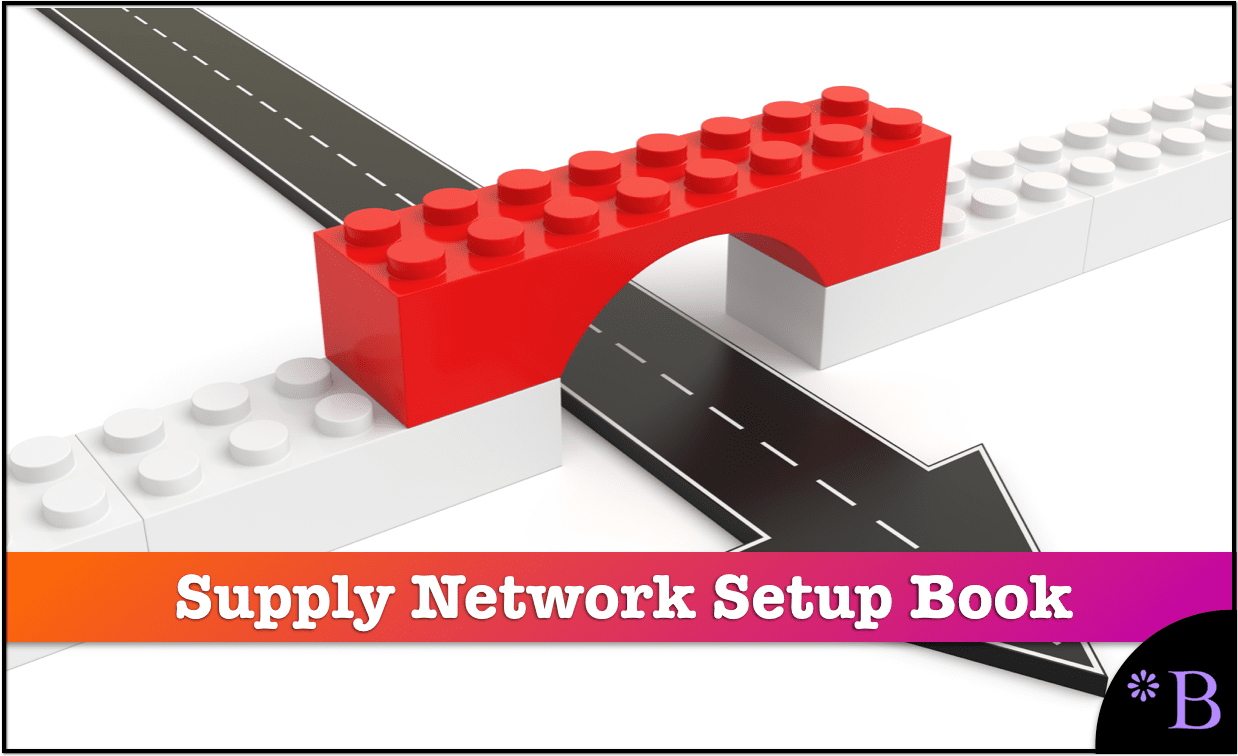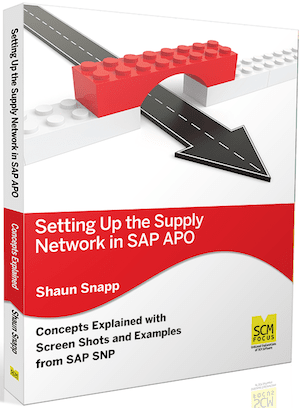
Setting Up the Supply Network in SAP APO
What The Book Covers
Never before has a supply planning book concentrated solely on setting up the Supply Network Planning (SNP) model in SAP APO, the most fully-featured supply chain planning suite on the market.
This book is the only book on supply planning to focus entirely on how to set up supply networks in APO, and how to meet highly-customized requirements that relate to supply network design. You won’t even find these topics covered in depth in SAP Training classes!
Companies should evaluate multiple supply network designs thoroughly before choosing a solution. The solution must strike a balance between meeting business requirements and being workable and maintainable. This book will teach you what you need to know to find this balance and evaluate solutions with confidence.
Through extensive use of graphics and screen images, this book will familiarize you with Supply Network Planning in SAP APO. It will show you what you need to do to design supply networks for real-life applications, where everyday business requirements necessitate a non-standard network design.
After reading this book, you will:
- Be able to set up master data objects for the supply network.
- Have a detailed understanding of the two significant data objects in APO: locations and transportation lanes.
- Understand multi-sourcing – the ability for a supply planning system to choose intelligently between alternate sources of supply.
- Know how to design the supply network for complicated and non-standard workflows, such as planning locations that are external to the supply network.
- Understand how to manage storage locations with MRP Areas for allocation and GATP.
- Be able to model inter-company transfers.
- Consider all aspects of network design, including physical master data set-up, parameters, planning run sequence, problem division, how and when billing documents are created, and more.
- Learn when a parallel simulation version of the supply network is appropriate — and when it is not.
Buy Now
A Book Based in Reality
The book provides many examples from real-life project experiences, the emphasis being on the reality of APO projects.
Interconnected to Web Information
In order the keep the book at a manageable and easily readable length, the book also provides numerous links out to the SCM Focus site, where supporting articles allow readers to get into more detail on topics that interest them.
Chapters
- Chapter 1: Introduction to the Supply Network
- Chapter 2: Locations in APO
- Chapter 3: Transportation Lanes
- Chapter 4: Sources of Supply and Multi-Sourcing
- Chapter 5: Managing Storage Locations with MRP Areas for Allocation and Global Available to Promise (GATP)
- Chapter 6: Modeling Intercompany Transfer
- Chapter 7: Capacity Constraining Vendor/Suppliers
- Chapter 7: Supply Network Simulation
- Chapter 8: Conclusion
Table of Contents
Chapter 1: Introduction to the Supply Network
- Reality-Based Writing
- Virtual Locations
- The Use of ScreenShots in the Book
- Disclaimer on The Field Definitions
- How Writing Bias is Controlled at Brightwork Research & Analysis and Brightwork Research & Analysis Press
- The Approach to the Book
- The Brightwork Research & Analysis Site
Chapter 2: Locations in APO
- The Location Priority
- How the Location Priority Works
- Different Location Field and Functionality
- Location Prioritization and Multi-Sourcing
- More Location Tabs in the Location Master
- Location Types
- ERP Locations
- Distribution Center
- Production Plant
- Customer
- Vendor/Supplier Locations
- Shipping Point Location
- Transportation Zones
- Stock Transfer Point
- Storage Location MRP Area
- Subcontractor
- Transportation Service Providers
- Terminal & Geographic Area and Store
- Conclusion
Chapter 3: Transportation Lanes
- Transportation Fields for Setting up the Supply Network
- Different Location Modeling Within APO Versus ERP
- Background on Planning Versus Execution Location to Location Movements
- The Importance of Incorporating Reality Into a Design
- The Problem With the Design
- How this Topic Dovetails with Redeployment
- Transportation Lead Times
- Essential Distinctions Between Supply Planning Systems
- Realistic Lead Times and the Need for Flexible Planning System Configuration
- Reasons Why Lead Times Can be Inaccurate
- Lead Time Sampling Bias
- Conclusion
Chapter 4: Sources of Supply and Multi-Sourcing
- How Sources of Supply Are Controlled in APO
- The Supply Network Planning Thread
- The Hierarchy/Sequence of Source of Supply Determination for The SNP Heuristic and CTM
- The Hierarchy/Sequence of Source of Supply Determination for CTM
- The Hierarchy/Sequence of Source of Supply Determination The SNP Network Optimizer and Sources of Supply
- The Deployment Planning Thread
- The Hierarchy/Sequence of Source of Supply Determination for The SNP Heuristic
- The Hierarchy/Sequence of Source of Supply Determination for CTM
- The Hierarchy/Sequence of Source of Supply Determination The SNP Optimizer and Sources of Supply
- Source of Supply and the SNP Cost Optimizer
- Understanding Multi-Sourcing
- The Multi-Sourcing Requirement
- The Reality of Multi-Sourcing
- Sources of Supply in PP/DS
- Time Validity of Source of Supply Controls
- Conclusion
Chapter 5: Managing Storage Locations with MRP Areas for Allocation and Global Available to Promise (GATP)
- MRP Areas in ECC
- MRP Area Storage Locations in APO
- MRP Areas in SAP ERP Versus Locations in APO
- Background on the Requirement for Inventory Allocation in ERP/Execution
- The Lack of Persistence of the CTM Created Allocations
- When Using GATP to Protect Allocations
- The Implications of this Design for SNP
- Conclusion
Chapter 6:Modeling Intercompany Transfer
- Intercompany Transfers Alternatives
- The Standard Billing STO
- Matching Purchase Order/Sales Order for Asymmetrical Intercompany Transfers
- Controlling Transfer of Ownership in ICO Movement
- Conclusion
Chapter 7: Capacity Constraining Vendors/Suppliers from Constraint Supply and Production Planning in SAP APO
- Technical Challenges of Modeling Supplier Capacity
- The Standard Approach: Modeling the Vendor Supplier as an Internal Location
- Conventional Modeling Approaches to Vendors/Suppliers
- Technical Set-Up of the Solution in SNP
- Supplier/Vendor Locations
- Disadvantages of the “Standard Approach”
- Technical Collaboration Challenges with SAP
- The Business Challenges of Modeling Supplier Capacity
- Conclusion
Chapter 8: Supply Network Simulation
Chapter 9: Conclusion

Buy Now
Questions about the Book?
Do you have any questions about the book? If so, please leave us a comment in the message box to the right, and we will address them.